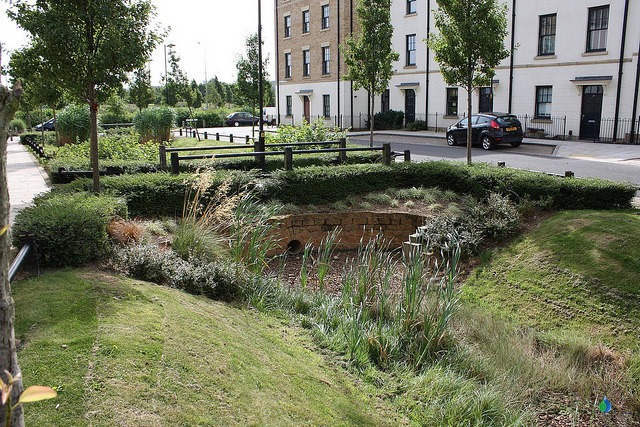How can SUDs be better integrated into the fabric of residential development?
Eleanor Trenfield, EDLA Director, discusses how SuDs can be core, multi-use features of schemes rather than simply functional necessities.
The core principle of Sustainable Urban Drainage Systems, (SuDS) is to offer a solution to slow and manage excess surface and rainwater, in both soft and hard landscapes. SuDS mimic natural drainage in a variety of ingenious ways, such as attenuation, infiltration, conveying and harvesting and using the rain close to where it falls. SuDS are not a new concept. They have been nature’s way of dealing with rainfall since time began.
But with much of the UK’s towns and cities located along rivers and urbanisation removing soft landscapes, (the earth’s natural sponges), alongside antiquated sewer systems, and the ever-increasing risk to cities and towns in intensity and frequency of floods borne out of rising sea levels. Never have SUDS been more vital for managing water in new residential developments and redevelopment projects.
However more often than not, the space making potential of SuDS, is not fully realised. This article talks to the fact that with a more integrated perspective across all disciplines and a better understanding, SuDS can be beautifully designed and become really attractive, interconnected amenities that enhance projects and offer significant biodiversity benefits and green space calculation advantages.
This article talks to the fact that with a more integrated perspective across all disciplines and a better understanding, SuDS can be beautifully designed and become really attractive, interconnected amenities
Too often SuDs basins are designed to be steeply sloping, highly efficient ‘engineered holes’ in the ground, with a life ring and wooden fences around them. But there are better ways to accommodate and integrate SuDS basins into a scheme, without impacting on functionality or the bottom line.
“It is our responsibility to show our clients, co-consultants and colleagues what is possible and why it is necessary.”
With informed creativity and a more integrated approach between all the professionals, most notably, Drainage Engineers, Landscape Architects and Ecologists, SuDS can be better designed to not only fulfil their primary function but also to offer integrated and accessible spaces for people to enjoy.
Ideas could include designing SuDs basins as seasonal amphitheatres, five side football pitches, paddling pools and play spaces. Plus, the opportunity to create tiered havens for wildlife within permanently wet sections of the basins and for people to enjoy.
There are so many missed opportunities to visibly enhance schemes and improve urban environments if SuDS are not considered from the start of the design process. This can lead to the basins invariably being placed at the centre of the development and ultimately form an unattractive, isolated hole.
SuDS can be better designed to not only fulfil their primary function but also to offer integrated and accessible spaces for people to enjoy. Ideas could include designing SuDs basins as seasonal amphitheatres, five side football pitches, paddling pools and play spaces.
The importance of SuDS should be reflected in the attention given to their design and management from the outset and throughout the project, particularly on larger developments that involves an multidisciplinary team.
When Landscape Architects are brought into the conversation, and SUDS are seen as part of the wider strategy from the start, wonderful things can happen. As a profession we must create the change we want to see and help our clients see the limitless potential of SuDS design.
It is our responsibility to show our clients, co-consultants and colleagues what is possible and why it is necessary. We also need to encourage local authorities to be more creative in their approach to SuDS, accepting thoughtfully designed basins as a crucial part of the green infrastructure, open space provision and wildlife enhancement on a project.

 ETLA Home Page
ETLA Home Page
 ETLA Home Page
ETLA Home Page
